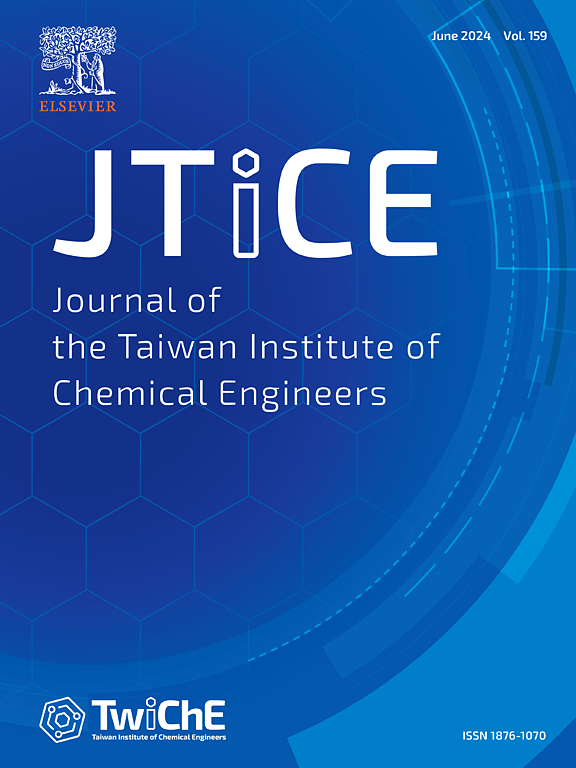Enhanced efficiency of superhydrophobic coatings: A comparative analysis between dip and spray techniques using octadecyltrichlorosilane
IF 5.5
3区 工程技术
Q1 ENGINEERING, CHEMICAL
Journal of the Taiwan Institute of Chemical Engineers
Pub Date : 2025-04-17
DOI:10.1016/j.jtice.2025.106150
引用次数: 0
Abstract
Background
Superhydrophobic surfaces with water contact angles (WCAs) of 150° or higher have drawn significant attention due to their exceptional water-repellent properties. Despite their potential, the fabrication of such surfaces is often hindered by complex, multi-step processes. This study presents a facile, scalable approach for generating superhydrophobic coatings using an octadecyltrichlorosilane (OTS) and ethanol (EtOH) mixture, all under ambient conditions.
Methods
Glass substrates were coated using both spray and dip coating techniques, followed by a detailed comparative analysis of the resulting surface properties. The same coating solution was then applied to aluminium, copper, plastic, and paper substrates, using both spray and dip methods.
Significant Findings
Coatings produced via spraying exhibited significantly higher surface roughness and achieved superhydrophobicity after just 11 cycles, an outcome unattainable by the dipping method, even with additional cycles. The OTS concentration and the number of coating cycles were key factors influencing surface morphology and topography. Notably, the aging of the OTS coating solution was found to affect the hydrophobicity and transparency of the substrate adversely. After just 3 h of aging, WCAs dropped below the superhydrophobic threshold, and light transmittance decreased to about 4 %. Despite differences in substrate properties, the spray coating method successfully conferred surface superhydrophobicity to a variety of materials.

提高超疏水涂层的效率:使用十八烷基三氯硅烷的浸镀和喷涂技术的比较分析
具有150°或更高的水接触角(WCAs)的超疏水表面由于其特殊的拒水性而引起了极大的关注。尽管具有潜力,但这种表面的制造往往受到复杂的多步骤工艺的阻碍。本研究提出了一种在环境条件下使用十八烷基三氯硅烷(OTS)和乙醇(EtOH)混合物生成超疏水涂层的简单、可扩展的方法。方法采用喷雾镀膜和浸渍镀膜两种技术对玻璃基板进行镀膜,并对镀膜后的表面性能进行了详细的对比分析。然后使用喷涂和浸渍方法将相同的涂层溶液应用于铝、铜、塑料和纸基材。通过喷涂产生的涂层在11次循环后表现出更高的表面粗糙度,并且达到了超疏水性,这是浸渍方法无法达到的结果,即使进行了额外的循环。OTS浓度和镀膜次数是影响表面形貌和形貌的关键因素。值得注意的是,OTS涂层溶液的老化会对基体的疏水性和透明度产生不利影响。时效仅3 h后,WCAs的超疏水阈值以下,透光率降至4%左右。尽管基材性能存在差异,但喷涂方法成功地将表面超疏水性赋予了各种材料。
本文章由计算机程序翻译,如有差异,请以英文原文为准。
求助全文
约1分钟内获得全文
求助全文
来源期刊
CiteScore
9.10
自引率
14.00%
发文量
362
审稿时长
35 days
期刊介绍:
Journal of the Taiwan Institute of Chemical Engineers (formerly known as Journal of the Chinese Institute of Chemical Engineers) publishes original works, from fundamental principles to practical applications, in the broad field of chemical engineering with special focus on three aspects: Chemical and Biomolecular Science and Technology, Energy and Environmental Science and Technology, and Materials Science and Technology. Authors should choose for their manuscript an appropriate aspect section and a few related classifications when submitting to the journal online.

 求助内容:
求助内容: 应助结果提醒方式:
应助结果提醒方式:


